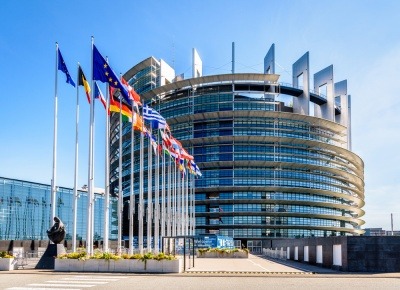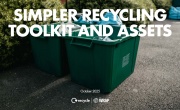EU passes legislation to tackle food waste and set up EPR for textiles
 Legislators have extended the scope of a key pillar in the EU’s waste legislation to reduce the environmental, economic and social impact of food waste and unwanted textiles.
Legislators have extended the scope of a key pillar in the EU’s waste legislation to reduce the environmental, economic and social impact of food waste and unwanted textiles.
Voting on a text put forward by the Commission at the end of last year, MEPs adopted amendments for more ambitious targets. Food waste generated from processing and manufacturing in Member States is to be reduced by 20 per cent by 2030, doubling the Commission’s proposal of 10 per cent. Similarly, for retail, restaurants, food services, and households, a 40 per cent per capita reduction target has been established, up from the Commission's proposed 30 per cent.
Furthermore, the Commission is required to assess the possibility of instituting even higher targets for 2035, suggesting at least 30 per cent and 50 per cent reductions in these sectors, respectively.
Textile waste also received significant attention, with the Parliament proposing to extend the scope of Extended Producer Responsibility (EPR) schemes. According to the new directive, producers who introduce textile products into the EU market will now be responsible for covering the expenses related to the collection, sorting, and recycling of waste textiles. Member States are mandated to set up these schemes within 18 months after the directive comes into effect, a more urgent timeline than the Commission's initially proposed 30 months.
Food waste prevention
Countries in the EU and the wider European Economic Area (EEA) are now tasked with implementing strategies covering the entire food supply chain, from farm to fork. The updated rWFD aims to encourage behavioural changes and increase public awareness, address inefficiencies in the food supply chain, including amendments made to promote the donation and redistribution of food for human consumption. They also enhance training and skill development, particularly supporting small and medium-sized enterprises and actors in the social economy.
To verify the effectiveness and adherence of these preventative measures, Member States must monitor their implementation rigorously, aiming for specified food waste reduction targets by 2030 based on 2020 levels. The European Commission is responsible for devising a unified methodology to measure food waste levels accurately, thereby establishing minimum quality standards for this assessment.
The Parliament has notably widened the directive's scope to emphasise not only waste prevention but also sustainability in food production. This expanded focus – bolstered by amendments – entails supporting behavioural change interventions and widespread information campaigns to elevate public consciousness about preventing food waste and encouraging more sustainable production practices. By shifting consumer behaviours, the aim is to address the root causes of food waste, cultivating a culture of sustainability and conservation across the EU.
Moreover, the Parliament has introduced targeted amendments to tackle inefficiencies in the food supply chain directly. This initiative fosters collaboration among stakeholders, ensuring a fair distribution of the costs and benefits associated with food waste prevention measures. A key proposal includes promoting fruits and vegetables that, despite having external defects, are still suitable for consumption—commonly known as "ugly" fruits and vegetables—challenging and changing market practices that lead to food waste.
Significant emphasis has been placed on updating the legislation to enhance food redistribution, education, and innovation to combat food waste. This includes encouraging food donation, prioritising human consumption over other uses, and supporting substantial investment in training and skill development across various sectors. The revised directive advocates for innovation and the adoption of technological solutions, like intelligent packaging to extend food shelf life and clearer date labelling on products, to reduce confusion and prevent unnecessary food waste. These integrated measures aim to collectively tackle food waste through a blend of redistribution, education, and technological innovation, promoting a more sustainable and equitable approach to food management from production to consumption.
Rapporteur Anna Zalewska highlighted the Parliament's efforts and objectives behind these amendments, stating: "Parliament has come up with targeted solutions to reduce food waste, such as promoting 'ugly' fruits and veggies, keeping an eye on unfair market practices, clarifying date labelling and donating unsold-but-consumable food."
However, the legislation has been criticised for not going far enough by members of the Food Waste Coalition, a group of 65 organisations from 22 countries, which stated: “[The] result is at odds with the European Parliament’s previous commitments to slash food waste by 50 per cent from farm to fork; a commitment expressed in the EU Green Deal and UN Sustainable Development Goals.”
Christophe Diercxsens, Global Public Affairs Director, Too Good To Go, commented: “Although the European Parliament’s vote today moves us in the right direction, the adopted targets are significantly lower than the EU’s prior commitment to UN SDG 12.3. Ambitious legally-binding food waste reduction targets are essential to bring all countries and all food businesses on board in the fight against food waste, not just a few.
“The targets do not apply equally to all steps of the food supply chain. Both the Commission proposal and the Parliament position set a far lower target for manufacturing and processing, and completely omit taking action against food losses and waste at farm level. With evidence from Kellogg’s showing that fast reductions are possible in the processing sector, this unequal treatment is not justified. Moreover, Eurostat data shows that at least 11 per cent of food is lost at primary production level. Meanwhile, the majority of food loss has been excluded from the EU measurement of food waste. This urgently needs to be rectified as current best estimates suggest that up to 90 million tonnes – 60 per cent of EU food waste – could occur on farms.”
EPR for textiles
The updated legislation introduces an Extended Producer Responsibility (EPR) scheme for textiles, significantly expanding the scope of producers' obligations to cover clothing and accessories, mattresses, carpets, and extending to goods made from materials such as leather and plastic.
According to the revised Article 22a, Member States are required to ensure that producers are accountable for the lifecycle of household textile products, articles of apparel, clothing accessories, and footwear, including those listed in Annex IVc ("textile, textile-related, and footwear products"). This accountability covers the initial market introduction within the territory of a Member State and encompasses a broad spectrum of responsibilities from collection to the final waste management stages.
Under this scheme, producers are mandated to cover costs associated with the collection, transport, sorting, preparation for re-use, recycling, and disposal of used and waste textile products. This aims to facilitate a circular economy within the textile industry, emphasising waste reduction and resource efficiency. Amendments to the Directive made by MEPs include specific actions to support information campaigns on sustainable consumption, waste prevention, and investing in research and development to enhance sorting and recycling processes, particularly focusing on scaling up fibre-to-fibre recycling.
Additionally, the Directive mandates the creation of a producer register (Article 22b), enhancing transparency and accountability by requiring producers to register and provide detailed information about the textile products they introduce to the market. This registry will be linked across Member States, facilitating easier registration and public access to information.
The EPR scheme's implementation, monitoring, and verification roles are clearly defined, with Member States ensuring that producers fulfil their responsibilities in a cost-efficient and transparent manner. Online retailers are also required to ensure compliance with the new rules covering products.
By December 31, 2025, and every five years thereafter, Member States are to conduct compositional surveys of collected mixed municipal waste to ascertain the share of waste textiles, guiding corrective actions to enhance the collection and recycling of textiles.
In response to the growing issue of microplastic pollution, the European Parliament has highlighted significant findings from the European Environmental Agency's briefing Microplastics from textiles in Europe. This briefing reveals that up to 35 per cent of global microplastics pollution in aquatic, terrestrial, and marine ecosystems originates from synthetic textiles. Recognising the urgent need to mitigate this pollution source, the revised directive emphasises the potential of appropriately collecting and recycling plastic waste from textiles.
Additionally, by the end of December 2025, the Commission is tasked with conducting a study to evaluate the application of end-of-waste criteria, as outlined in Article 6 of the Directive, specifically for plastic polymers prevalent in solid marine litter, such as polyamide. Based on this study, the Commission may implement acts to establish detailed measures for the uniform application of Union-wide end-of-waste criteria for marine litter. This approach will consider the best practices already in place within Member States, underlining a proactive stance towards addressing and reducing the impact of microplastics, particularly from textiles, on the environment.
Following the vote of 514 MEPs for the First Reading of the latest revision to the Waste Framework Directive (with 20 against and 91 abstentions), the legislation is now forwarded to the Council of the European Union for approval or amendments to return it back to the European Parliament.







